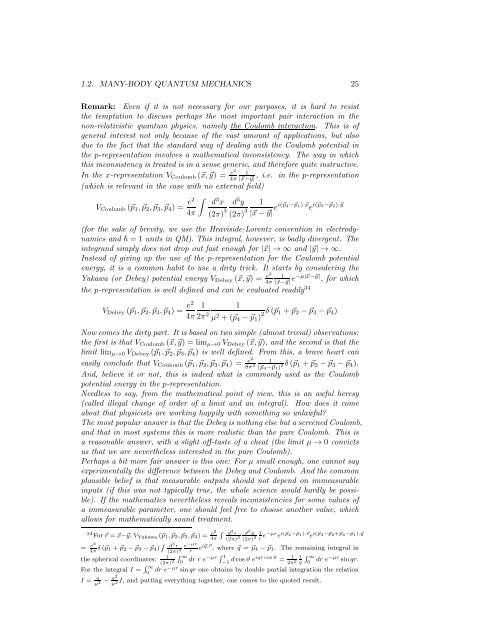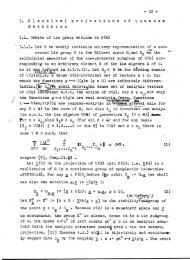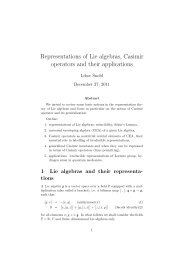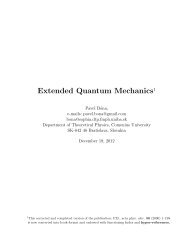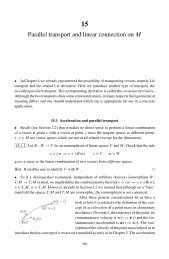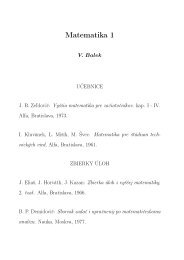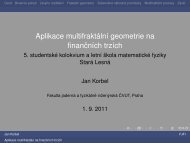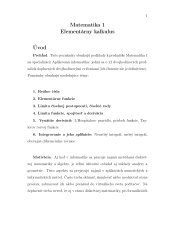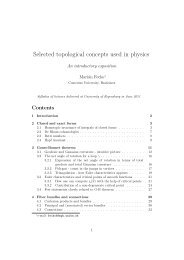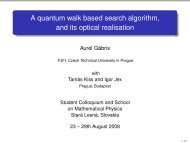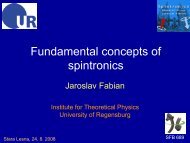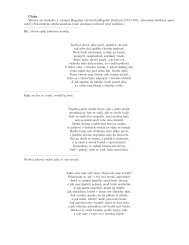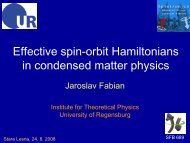Quantum Field Theory I
Quantum Field Theory I
Quantum Field Theory I
You also want an ePaper? Increase the reach of your titles
YUMPU automatically turns print PDFs into web optimized ePapers that Google loves.
1.2. MANY-BODY QUANTUM MECHANICS 25<br />
Remark: Even if it is not necessary for our purposes, it is hard to resist<br />
the temptation to discuss perhaps the most important pair interaction in the<br />
non-relativistic quantum physics, namely the Coulomb interaction. This is of<br />
general interest not only because of the vast amount of applications, but also<br />
due to the fact that the standard way of dealing with the Coulomb potential in<br />
the p-representation involves a mathematical inconsistency. The way in which<br />
this inconsistency is treated is in a sense generic, and therefore quite instructive.<br />
1<br />
|⃗x−⃗y|<br />
In the x-representation V Coulomb (⃗x,⃗y) = e2<br />
4π<br />
(which is relevant in the case with no external field)<br />
V Coulomb (⃗p 1 ,⃗p 2 ,⃗p 3 ,⃗p 4 ) = e2<br />
4π<br />
∫<br />
, i.e. in the p-representation<br />
d 3 x<br />
(2π) 3 d 3 y<br />
(2π) 3 1<br />
|⃗x−⃗y| ei(⃗p4−⃗p1).⃗x e i(⃗p3−⃗p2).⃗y<br />
(for the sake of brevity, we use the Heaviside-Lorentz convention in electrodynamics<br />
and = 1 units in QM). This integral, however, is badly divergent. The<br />
integrand simply does not drop out fast enough for |⃗x| → ∞ and |⃗y| → ∞.<br />
Instead of giving up the use of the p-representation for the Coulomb potential<br />
energy, it is a common habit to use a dirty trick. It starts by considering the<br />
Yukawa (or Debey) potential energy V Debey (⃗x,⃗y) = e2 1<br />
4π |⃗x−⃗y| e−µ|⃗x−⃗y| , for which<br />
the p-representation is well defined and can be evaluated readily 34<br />
V Debey (⃗p 1 ,⃗p 2 ,⃗p 3 ,⃗p 4 ) = e2 1 1<br />
4π 2π 2 µ 2 +(⃗p 4 −⃗p 1 ) 2δ(⃗p 1 +⃗p 2 −⃗p 3 −⃗p 4 )<br />
Now comes the dirty part. It is based on two simple (almost trivial) observations:<br />
the first is that V Coulomb (⃗x,⃗y) = lim µ→0 V Debey (⃗x,⃗y), and the second is that the<br />
limit lim µ→0 V Debey (⃗p 1 ,⃗p 2 ,⃗p 3 ,⃗p 4 ) is well defined. From this, a brave heart can<br />
easily conclude that V Coulomb (⃗p 1 ,⃗p 2 ,⃗p 3 ,⃗p 4 ) = e2 1<br />
8π<br />
δ(⃗p 3 (⃗p 4−⃗p 1) 2 1 +⃗p 2 −⃗p 3 −⃗p 4 ).<br />
And, believe it or not, this is indeed what is commonly used as the Coulomb<br />
potential energy in the p-representation.<br />
Needless to say, from the mathematical point of view, this is an awful heresy<br />
(called illegal change of order of a limit and an integral). How does it come<br />
about that physicists are working happily with something so unlawful<br />
The most popular answer is that the Debey is nothing else butascreenedCoulomb,<br />
and that in most systems this is more realistic than the pure Coulomb. This is<br />
a reasonable answer, with a slight off-taste of a cheat (the limit µ → 0 convicts<br />
us that we are nevertheless interested in the pure Coulomb).<br />
Perhaps a bit more fair answer is this one: For µ small enough, one cannot say<br />
experimentally the difference between the Debey and Coulomb. And the common<br />
plausible belief is that measurable outputs should not depend on immeasurable<br />
inputs (if this was not typically true, the whole science would hardly be possible).<br />
If the mathematics nevertheless reveals inconsistencies for some values of<br />
a immeasurable parameter, one should feel free to choose another value, which<br />
allows for mathematically sound treatment.<br />
34 ∫<br />
For⃗r = ⃗x−⃗y, V Yukawa (⃗p 1 ,⃗p 2 ,⃗p 3 ,⃗p 4 ) = e2 d<br />
3 r d 3 y 1<br />
4π (2π) 3 (2π) 3 r e−µr e i(⃗p 4−⃗p 1 ).⃗r e i(⃗p 3−⃗p 2 +⃗p 4 −⃗p 1 ).⃗y<br />
= e2<br />
4π δ(⃗p 1 +⃗p 2 − ⃗p 3 −⃗p 4 ) ∫ d 3 r e −µr<br />
(2π) 3 e r i⃗q.⃗r , where ⃗q = ⃗p 4 − ⃗p 1 . The remaining integral in<br />
∫ 1<br />
the spherical coordinates: ∞<br />
(2π) 2 0 dr r ∫ e−µr 1<br />
−1 dcosϑ eiqrcosϑ = 1 ∫ 1 ∞<br />
2π 2 q 0 dr e−µr sinqr.<br />
For the integral I = ∫ ∞<br />
0 dr e−µr sinqr one obtains by double partial integration the relation<br />
I = q<br />
µ 2 − q2<br />
µ 2 I, and putting everything together, one comes to the quoted result.


